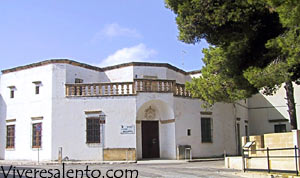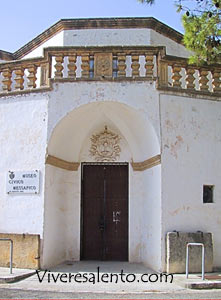|
|

| Inhabitants'name:
Aletini
|
The civic coat of arms
of Alezio has a phoenix on a blue background and Greek inscription that means
 “Alexias”,
the name of the village in the 4th century B.C. The village grew
always bigger and bigger and became a rich town as we can understand for the
archaeological findings of this area. Alezio was a flourishing town in the Roman
period since it had about 70 thousand inhabitants. The Roman name of the town
was Aletium and it was on the Via Traiana which went from the Salento to Rome.
We find the name of Aletium in the books by Plinio the Old and by Tolomeus. The
legend says that St Peter passed from Alezio and baptized the whole population
with the water of a well that still exists today. When the Roman Empire fell
down nothing could protect the Salento from the barbarian invasions and so the
Saracens came in the 10th century and razed Alezio to the ground.
Those who survived had to “Alexias”,
the name of the village in the 4th century B.C. The village grew
always bigger and bigger and became a rich town as we can understand for the
archaeological findings of this area. Alezio was a flourishing town in the Roman
period since it had about 70 thousand inhabitants. The Roman name of the town
was Aletium and it was on the Via Traiana which went from the Salento to Rome.
We find the name of Aletium in the books by Plinio the Old and by Tolomeus. The
legend says that St Peter passed from Alezio and baptized the whole population
with the water of a well that still exists today. When the Roman Empire fell
down nothing could protect the Salento from the barbarian invasions and so the
Saracens came in the 10th century and razed Alezio to the ground.
Those who survived had to move to the near villages leaving Alezio as a ghost town. In the Angevin period
there was a small village called ‘Villa Picciotti’ in this area and was ruled by
Gallipoli. This village was named after Francisco Alemanno whose nickname was
‘picciotto’. He was a rich landowner who gave some land to the farmers for them
to cultivate it or build their house. Until 1854 Alezio was under the
administration of Gallipolis and the King Vittorio Emanuele II chose to change
the name of the village. Among the native people of Alezio we remember : the
abbot De Simone who taught Arabian at University and Mr Tafuri who took his
degree in a very short time then became an appreciated and famous lawyer. Enrico
Giannelli lived in the 19th century and studied in the Istituto delle
Belle Arti in Naples. He was a great painter and his works are showed in Naples,
Moscow, New York and London. Mateo Perez was born in 1547 and moved to Rome in
1566 where he became a famous and appreciated painter. He took part to the
painting of the Cappella Sistina and worked for pope
Pio V and Gregorio XIII. Later he moved to Malta. In
1616 he died in Lima, Peru.
move to the near villages leaving Alezio as a ghost town. In the Angevin period
there was a small village called ‘Villa Picciotti’ in this area and was ruled by
Gallipoli. This village was named after Francisco Alemanno whose nickname was
‘picciotto’. He was a rich landowner who gave some land to the farmers for them
to cultivate it or build their house. Until 1854 Alezio was under the
administration of Gallipolis and the King Vittorio Emanuele II chose to change
the name of the village. Among the native people of Alezio we remember : the
abbot De Simone who taught Arabian at University and Mr Tafuri who took his
degree in a very short time then became an appreciated and famous lawyer. Enrico
Giannelli lived in the 19th century and studied in the Istituto delle
Belle Arti in Naples. He was a great painter and his works are showed in Naples,
Moscow, New York and London. Mateo Perez was born in 1547 and moved to Rome in
1566 where he became a famous and appreciated painter. He took part to the
painting of the Cappella Sistina and worked for pope
Pio V and Gregorio XIII. Later he moved to Malta. In
1616 he died in Lima, Peru.
|